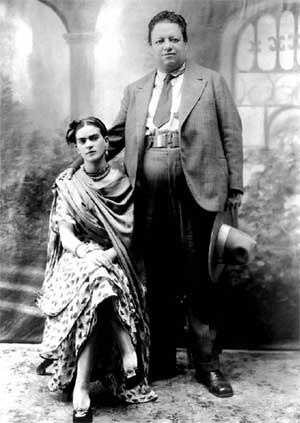Discovering the artist
Frieda Kahlo
Frieda Kahlo
The famous philosopher Socrates is known for saying, "The unexamined life is not worth living". Self discovery is an on going self evolution of observation and change. It can begin at a young age or not. The artist Frida Kahlo was such a human self observer. As a painter, she produced works that depicted her true self from her Mexican heritage to her political convictions. Art allows one to go where mere words cannot.
Frida Kahlo (6 July 1907 – 13 July 1954) was a Mexican painter known for her many portraits, self-portraits, and works inspired by the nature and artifacts of Mexico. Inspired by the country's popular culture, she employed a naïve folk art style to explore questions of identity, post-colonialism, gender, class, and race in Mexican society. Her paintings often had strong autobiographical elements and mixed realism with fantasy. Kahlo has been described as a surrealist because of her imaginary graphical elements.
Kahlo's paintings often feature root imagery, with roots growing out of her body to tie her to the ground. This reflects in a positive sense the theme of personal growth; in a negative sense of being trapped in a particular place, time and situation; and in an ambiguous sense of how memories of the past influence the present for either good and/or ill.
Kahlo's paintings often feature root imagery, with roots growing out of her body to tie her to the ground. This reflects in a positive sense the theme of personal growth; in a negative sense of being trapped in a particular place, time and situation; and in an ambiguous sense of how memories of the past influence the present for either good and/or ill.
Kahlo's work as an artist remained relatively unknown until the late 1970s, when her work was rediscovered by art historians and political activists. By the early 1990s, she had become not only a recognized figure in art history, but also regarded as an icon for Chicanos, the feminism movement and the LGBTQ+ movement. Kahlo's work has been celebrated internationally as emblematic of Mexican national and indigenous traditions and by feminists for what is seen as its uncompromising depiction of the female experience and form.
On September 17th 1925 Frida and her friend Alex was riding in a bus when it crashed into a street trolley car. Due to the grave injuries she suffered in the accident, Frida had to undergo 35 operations in her life, bear with relapses of extreme pain and could not have children. During the period of three months after the accident in which she was immobile, Frida made several paintings, mostly self-portraits which she made using the mirror across her bed. This led to Frida abandoning her career in medicine and becoming an artist.
Kahlo and her artist husband Diego Rivera
Kahlo admired the work of the famous Mexican painter Diego Rivera. She first approached him in 1927. Rivera was impressed with her work and encouraged her which contributed in Frida becoming an artist. Soon their relationship became intimate and they married on August 21, 1929 when he was 42 and she was 22. It was Rivera’s third marriage. People often referred to the couple as “The Elephant and the Dove” due to the difference in their size.
Self Portrait called The Two Fireda’s
The painting was the first large-scale work done by Kahlo and is considered one of her most notable paintings. It is a double self-portrait, depicting two versions of Kahlo seated together. One is wearing a white European-style Victorian dress while the other is wearing a traditional Tehuana dress. Kahlo painted The Two Fridas in 1939, the same year she divorced artist Diego Rivera,[1] although they remarried a year later.
Some art historians have suggested that the two figures in the painting are a representation of Frida's dual heritage. Her father, Guillermo Kahlo, was German; while her mother, Matilde Calderon, was Mestizo (a mix of Spanish and Native American). Another interpretation is that the Tehuana Frida is the one who was adored by her husband Diego Rivera, while the European Frida is the one that was rejected by him. In Frida's own recollection, the image is of a memory of a childhood imaginary friend.
Both Fridas hold items in their lap; the Mexican Frida holds a small portrait of Diego Rivera, and the European Frida holds forceps. Blood spills onto the European Frida's white dress from a broken blood vessel that has been cut by the forceps. The blood vessel connects the two Fridas, winding its way from their hands through their hearts. The work alludes to Kahlo's life of constant pain and surgical procedures and the Aztec tradition of human sacrifice. Because this piece was completed by Kahlo shortly after her divorce, the European Frida is missing a piece of herself, her Diego.
The Wounded Deer by Frida Kahlo
In this painting, Frida used a young deer with the head of herself and was fatally wounded by a bunch of arrows. The background is the forest with dead trees and broken branches, which implied the feeling of fear and desperation. Far away is the stormy, lightning-lit sky which brings some hope but the dear will never be able to reach it.
In 1946 Frida Kahlo had an operation on her spine in New York. She was hoping this surgery would free her from the severe back pain but it failed. This painting expressed her disappointment towards the operation. After she went back to Mexico, she suffered both the physical pain and emotional depression. In this painting she depicted herself as a young stag with her own head crowned with antlers. This young stag is pierced by arrows and bleeding. At the lower-left corner, the artist wrote down the word "Carma", which means "destiny" or "fate". Just like her other self-portraits, in this painting Frida expressed the sadness that she cannot change her own fate.
Frida used her pet deer "Granizo" as the model when she painted this portrait. She had many pets which she used as her surrogate children and deer is her favorite kind.
This painting has multiple interpretations from different people. Some said it expressed her frustration over the botched surgery. Others said it portrays her incapability to control her own destiny. And some people said it has sexual implication and expressed her struggles in different relationship.
On May 3, 1946, Frida gave this painting to her friends Lina and Arcady Boitler as a wedding gift. With it she included a note that said: "I leave you my portrait so that you will have my presence all the days and nights that I am away from you".
Weeping Coconuts
In this painting, she uses coconut to project her pain and frustration hence, the portrayal of a weeping coconut. Kahlo created the Weeping Coconuts painting at a time when she relied on prescription medication to ease her chronic pain. She often mixed the painkillers with alcohol, which affected her ability to paint with detail.
In her career, Frida Kahlo created 143 paintings out of which 55 are self-portraits. Kahlo said, “I paint myself because I am so often alone and because I am the subject I know best.” Her self portraits often include interpretations of physical and psychological wounds. Frida Kahlo’s self-portraits are considered among the finest ever created. Her most famous self-portrait is perhaps ‘Self-Portrait with Thorn Necklace and Hummingbird’.
Similarly to many other contemporary Mexican artists, Kahlo was heavily influenced by Mexicanidad, a romantic nationalism that had developed in the aftermath of the revolution.The Mexicanidad movement claimed to resist the "mindset of cultural inferiority" created by colonialism, and placed special importance on indigenous cultures. Before the revolution, Mexican folk culture – a mixture of indigenous and European elements – was disparaged by the elite, who claimed to have purely European ancestry and regarded Europe as the definition of civilization which Mexico should imitate. Kahlo's artistic ambition was to paint for the Mexican people, and she stated that she wished "to be worthy, with my paintings, of the people to whom I belong and to the ideas which strengthen me". To enforce this image, she preferred to conceal the education she had received in art. Instead, she cultivated an image of herself as a "self-taught and naive artist".
Kahlo’s health issues became nearly all-consuming in 1950. After being diagnosed with gangrene in her right foot, Kahlo spent nine months in the hospital and had several operations during this time. She continued to paint and support political causes despite having limited mobility. In 1953, part of Kahlo’s right leg was amputated to stop the spread of gangrene.
Deeply depressed, Kahlo was hospitalized again in April 1954 because of poor health, or, as some reports indicated, a suicide attempt. She returned to the hospital two months later with bronchial pneumonia. No matter her physical condition, Kahlo did not let that stand in the way of her political activism. Her final public appearance was a demonstration against the U.S.-backed overthrow of President Jacobo Arbenz of Guatemala on July 2nd.
Kahlo died 20 days after her 47th birthday on July 26, 1954. A few days before her death, she wrote in her diary: “I hope the exit is joyful — and I hope never to return — Frida”. There has been some speculation regarding the nature of her death. It was reported to be caused by a pulmonary embolism, but there have also been stories about a possible suicide.
Take a virtual tour of Frieda’s home she titled The Blue House. Leave your comment and assessment in the form box below. This counts for two assignments. Paste the following web address into your address bar:
https://www.museofridakahlo.org.mx/en/the-blue-house/virtual-tour/
Kahlo’s funeral and open casket
Kahlo was moderately successful during her lifetime and it was only several years after her death that her work became widely acclaimed. During her lifetime she was mainly known in Mexico as Rivera’s wife, now she is popular worldwide and Rivera is known as her husband.








